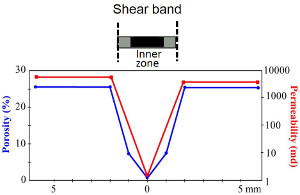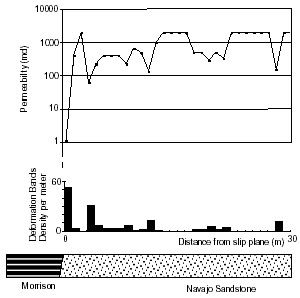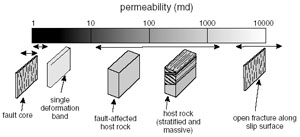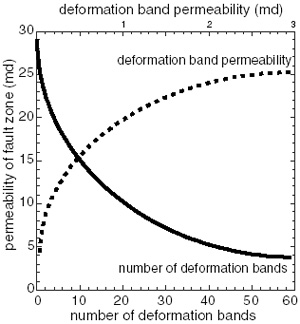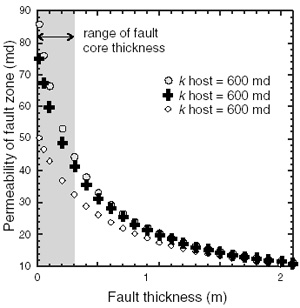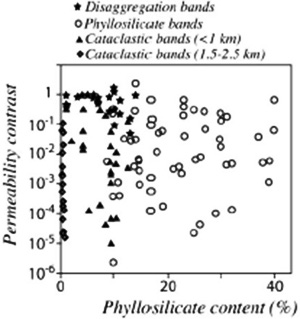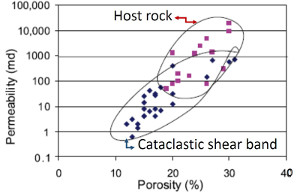| |||||||||||||||
|
|
|||||||||||||||
|
|
|||||||||||||||
| Porosity and Permeability of Shear Bands | |||||||||||||||
|
A wide range of shear band permeability values is reported in the literature. Antonellini and Aydin (1994) studied permeability of shear bands from the Entrada and Navajo sandstones at the Arches national Park, southeastern Utah by using mini-permeameter and image analysis technique. They reported that the shear bands that they studied have on average a permeability three orders of magnitude less than those of the surrounding host rock. However, the permeability distribution across a simple shear band is not uniform (Figure 1). Furthermore, they determined that the permeability across a thin zone adjacent to a slip surfaces associated with shear band zones is several order of magnitudes lower than that of the host rock (Figure 2). Also see Aydin et al. (2006) for a perspective of a broader class, deformation band permeability and porosity. Shipton et al. (2002) measured permeability of deformation bands and deformation band-based faults with slip surfaces (nomenclature is the same as the original authors) from drill cores extracted from the Navajo sandstone in the San Rafael Swell, Utah, using a probe permeameter. They identified four types of structures at and around the fault cores with different representative permeability values as shown in Figure 3.
The fault core consists of closely spaced individual shear bands and represents the highest permeability reduction. Permeability values decline from 1000 md of host rocks to around 1 md near the fault core or near the shear band cluster. Outside of the fault zone, permeability returns to the background values in the range of 100 to 1000 mD. The calculated bulk permeability values over length scales of 5 to 10 m are 30 to 40 mD. These authors using the Transmissibility Multiplier method developed by Manzocchi et al. (1999) determined upscale permeability of shear band zones and suggested that the upscaled permeability values depend on the the number of the bands (Figure 4), their spacing, and the thickness of the fault zone (Figure 4, Figure 5 and Figure 6).
Fossen et al. (2007) linked the variation of shear band permeability values in part to the specific lithology of sandstones and the formation mechanisms and architecture of shear bands (Figure 7). The values in their plot are particularly sensitive to the clay content of the host rock (phyllosilicate in the plot) and to the mechanism of deformation, particularly cataclastic deformation and disaggregation in their nomenclature. In a different study, Torabi and Fossen (2009) verified this result and concluded that cataclastic shear band permeability is lower than that of the host rock for the same porosity (Figure 8), but the wide range of variation reported in the literature is probably due to lateral variation of petrophysical properties (presumably both the bands and host rocks).
Tondi et al (2005, 2006) using CT scan determined porosity decrease from about 20% in the host rock to about 5% or less in the shear bands (Figure 9) in carbonate grainstone. These results indicate that the porosity and permeability reduction of comparable magnitude may occur in shear bands in a different lithology aside from sandstone.
| |||||||||||||||
| Reference: |
|||||||||||||||
| Antonellini, M., Aydin, A., 1994 Aydin, A., Borja, R., Eichhubl, P., 2006 Fossen, H., Schultz, R.A., Shipton, Z.K., Mair, K., 2007 Manzocchi, T., Walsh, J.J., Nell, P., Yielding, G., 1999 Shipton, Z.K., Evans, J.P., Robeson, K.R., Forster, C.B., Snelgrove, S., 2002 Tondi, E., Antonellini, M., Aydin, A., Marchegiani, L., Cello, G., 2005 Tondi, E., Antonellini, M., Aydin, A., Marchegiani, L., Cello, G., 2006 |
|||||||||||||||
|
Readme | About Us | Acknowledgement | How to Cite | Terms of Use | Ⓒ Rock Fracture Knowledgebase |
|||||||||||||||
